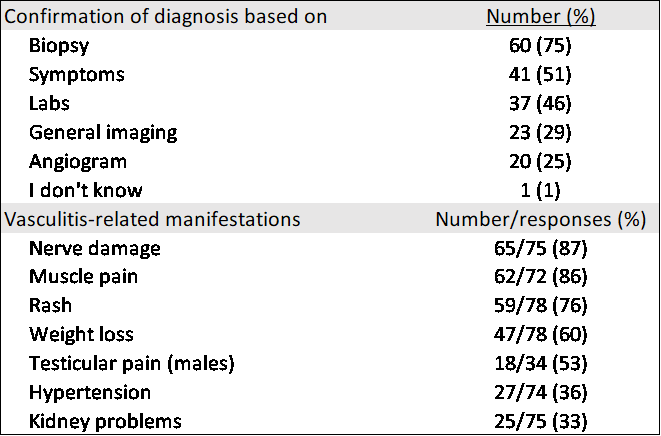Session Information
Date: Tuesday, November 9, 2021
Title: Vasculitis – Non-ANCA-Associated & Related Disorders Poster II (1862–1888)
Session Type: Poster Session D
Session Time: 8:30AM-10:30AM
Background/Purpose: Polyarteritis nodosa (PAN) is form of medium-vessel vasculitis with an estimated annual incidence of 1 per million. The rarity of the disease makes traditional center-based approaches to research in PAN challenging. The purpose of this study was to describe an internet-based cohort of participants with a self-reported diagnosis of PAN, and, to determine how many patients met established criteria for this disease.
Methods: Participants with a self-reported diagnosis of PAN were included in a prospective, internet-based, longitudinal registry from November 2014 to May 2020. All patients completed standardized forms collecting data on disease manifestations, diagnostic testing, and treatment. Patients reporting a history of a positive test for ANCA (n=19) were excluded.
Results: 80 participants (58% female) self-reported a diagnosis of PAN without a history of ANCA. Two participants reported a history of hepatitis B viral infection. Race/ethnicity distribution: 87% Caucasian/White, 9% Asian, 8% Hispanic/Latino, 5% African American/Black, and 1% Native American. Enrollment included participants from across the world including North America (57), Europe (8), Australia (3), Asia (2), and South America (1). The mean age of onset of symptoms and diagnosis was 42.7 (SD 0.28) and 44.1 (SD 0.30) years. Only 13 participants (16%) were > 65 years old at the time of registration. Four participants were < 18 years old at the onset of symptoms.
Patients reported that the diagnosis was made based on biopsy (75%), symptoms (51%), laboratory studies (46%), or angiogram (25%) (Table 1). The most common manifestations of vasculitis included: nerve damage (87%), muscle pain (86%), skin involvement (76%), weight loss (60%), and testicular pain (53% of males) (Table 1). Blood clots were reported in 18%. 6 participants reported only skin involvement. The majority (83%) of patients reported that a rheumatologist was their treating physician (Table 2). The most common drug exposures included glucocorticoids (86%), cyclophosphamide (49%), and azathioprine (45%) (Table 2). 95% of participants met the 1990 American College of Rheumatology Classification Criteria for PAN. 95% of participants met the 2012 Chapel Hill Consensus Conference Definition of PAN.
Conclusion: In an internet platform based on self-reported patient information, the majority of patients met well-established criteria for PAN and reported disease manifestations in similar frequencies to published data from physician-reported cohorts. These results support the use of online patient cohorts to conduct research in PAN.
 Table 1: Means of diagnostic confirmation and manifestations of polyarteritis nodosa.
Table 1: Means of diagnostic confirmation and manifestations of polyarteritis nodosa.
 Table 2: Treating physicians and reported medications at enrollment.
Table 2: Treating physicians and reported medications at enrollment.
To cite this abstract in AMA style:
Springer J, Kermani T, Shaw D, Young K, Burroughs C, Merkel P. Description of an Internet-Based Cohort with a Self-Reported Diagnosis of Polyarteritis Nodosa [abstract]. Arthritis Rheumatol. 2021; 73 (suppl 9). https://acrabstracts.org/abstract/description-of-an-internet-based-cohort-with-a-self-reported-diagnosis-of-polyarteritis-nodosa/. Accessed .« Back to ACR Convergence 2021
ACR Meeting Abstracts - https://acrabstracts.org/abstract/description-of-an-internet-based-cohort-with-a-self-reported-diagnosis-of-polyarteritis-nodosa/
